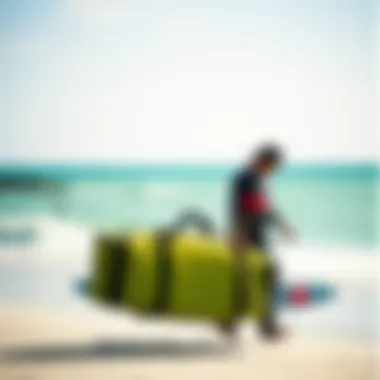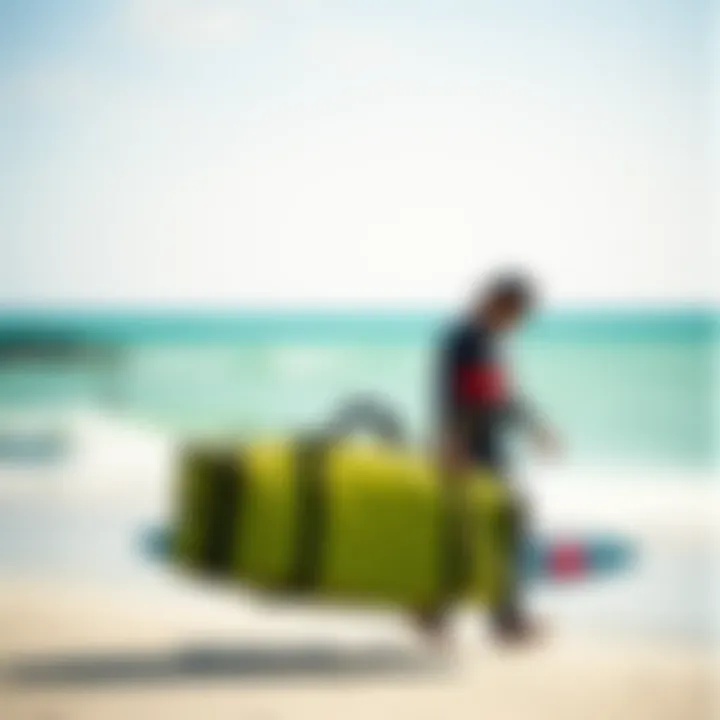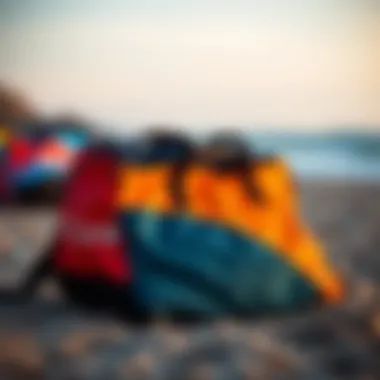The Significance of Kite Bags in Kiteboarding Culture


Intro
In the world of kiteboarding, gear is not just about functionality; it embodies an athlete's identity and culture. Among the most vital components of kiteboarding gear is the kite bag. Though often overlooked, kite bags fulfill a critical role in protecting equipment, ensuring ease of transport, and even fostering a sense of community among the kiteboarding enthusiasts.
With so many diverse designs available, kite bags come in shapes and sizes tailored to the needs of riders. The choice of materials, compartments, and even aesthetic appeal all contribute to their significance. Each kite bag speaks to the rider’s preferences, experiences, and aspirations on the water.
As we delve deeper into the fascinating world of kite bags, we will explore various types, their functionality, and their cultural importance. This rich narrative not only reveals what’s stored inside these bags, but also the stories they carry, which resonate with many riders around the globe.
Gear Selection
Types of Kites
Choosing the right kite is foundational for every rider, and equally, understanding how to transport that kite effectively hinges on having the right bag. There are a multitude of kite types designed for different skill levels and riding styles. For example:
- Freeride Kites: These are versatile and easy to handle, making them perfect for beginners. They are often found in bags that offer protection and an easy carry option.
- Wave Kites: Designed for specific conditions, these might come in reinforced bags to accommodate the robust demands of ocean riding.
- Race Kites: Built for speed, these kites often have specialized folding features that can be crucial in high-stake competitions.
Each type of kite not only requires protective packaging but also influences how riders interact with their gear. A well-designed kite bag allows for an easy setup and takedown on the beach, which can make all the difference.
Choosing the Right Board
Just as crucial as selecting a kite, the choice of board is equally significant. The right kiteboard complements the kite and overall riding performance. When selecting a board, consider what’s practical for your riding style. It’s hard to find boards that are a one-size-fits-all solution, but knowing your options can streamline the process:
- Directional Boards: These offer great performance in surf conditions, so a bag designed to cradle these boards securely is invaluable.
- Twin-Tip Boards: Preferable for those who enjoy tricks and jumps, these often fit into bags with adjustable compartments that provide extra padding and protection.
When bags are made specific to accommodate either board type, they tend to come with extra features like straps or wheels. This not only increases convenience but also underscores the importance of investing in quality bags that reflect your riding intentions.
"Investing in a good kite bag can be the difference between a smooth experience on the water and a frustrating one on the beach."
In the end, both kites and boards come together in a harmonious symphony of performance, and kite bags serve as the conductors that unite them.
End
The journey through the multifaceted nature of kite bags has only just begun. These essential accessories are not merely practical items; they signify a deeper connection to the sport itself. By recognizing the significance of gear selection and understanding our unique preferences, kiteboarders can elevate their experience on the water and strengthen their bonds with the community. As you gear up for your next adventure, consider the weight your kite bag carries, both in style and meaning.
Preface to Kite Bags
Kite bags play an essential role in the world of kiteboarding, serving multiple functions that extend beyond simple storage. They are pivotal for the protection of gear, ease of transportation, and the organization of equipment, each aspect contributing significantly to the user's overall kiteboarding experience. Understanding the elements that define kite bags opens up a wider discussion about how they integrate into the lives of kiteboarders, whether they are seasoned professionals or newcomers.
Being an avid kiteboarder means investing not just in high-quality kites but also in the necessary tools to safeguard them. Kite bags provide a buffer against the elements and potential damage during transport. Riders often find themselves navigating through crowded beaches or remote access points, where easily handling gear proves invaluable. Therefore, the design features of these bags—such as padded compartments and durable exteriors—are not mere details but essential characteristics that can make or break an outing.
Moreover, kite bags don’t just protect physical items; they reflect the identity of the rider. Many kiteboarders personalize their bags with styles and colors that resonate with their personality, embedding a touch of individuality into what is fundamentally a practical accessory. This relationship with equipment fosters a sense of community among enthusiasts, where a simple kite bag can serve as a conversation starter, a badge of honor, or even a testament to adventures enjoyed together.
The importance of kite bags can’t be overstated. They embody the spirit of kiteboarding while simultaneously addressing practical concerns in gear management. As we delve deeper into their significance, understanding what constitutes a kite bag, along with its historical context, reveals a fascinating background that enriches our appreciation for this often-overlooked component of the sport.
Defining the Kite Bag
A kite bag is more than just a receptacle for storing kites and gear; it is a purpose-built container designed to hold and protect the essential equipment needed for kiteboarding. These bags can vary in style, size, and design, catering to specific preferences and requirements of the rider.
Typically, a kite bag includes compartments for storage of the canopy, lines, and sometimes additional items such as a harness or safety gear. The use of durable materials such as nylon or polyester ensures resistance against abrasion and water, making them suitable for dynamic environments. The configuration often includes padded sections to safeguard the kite from impacts, particularly when being transported in a vehicle or during travel.
In practice, kite bags can be seen in various forms—from sleek, minimalist backpacks for quick trips to large, wheeled bags for extensive travels. This differentiation not only serves to accommodate the diverse needs of kiteboarders but also reflects the art of customization, allowing users to choose models that align with their style, gear quantity, and usage scenarios. Kite bags have essentially become a canvas for personal expression, with many riders opting for custom designs or unique colors that stand out at the beach.
Historical Context
The evolution of the kite bag mirrors the growth of kiteboarding itself, tracing back to its roots in the late 20th century. Initially, riders relied on makeshift solutions to transport their kites, often settling for regular duffel sacks or generic backpacks. As the sport gained traction, the demand for specialized gear surged, leading manufacturers to innovate and develop dedicated bags tailored for the specific needs of kiteboarders.
In the early days, kite bags were purely functional—often utilitarian with little focus on aesthetics. However, as kiteboarding transformed into a more mainstream sport in the 2000s, design sophistication began to play a substantial role. The introduction of padded compartments, weather-resistant materials, and ergonomic designs marked a significant shift in the market. This evolution not only reflected technological advancements in materials but also the growing community of enthusiasts who sought gear that aligned with their lifestyles and identities.
Today, kite bags are a standard aspect of kiteboarding culture, symbolizing more than just technical utility. They hold a narrative intertwined with personal journeys, adventures, and community bonds formed on the water. The increased variety in designs and functionalities showcases a vibrant market committed to enhancing the kiteboarding experience, making these bags indispensable to the sport's ongoing legacy.


The Importance of Kite Bags
In the vibrant world of kiteboarding, the kite bag stands as more than just a simple accessory. It carries an essential role, impacting not just the convenience of the sport but also the longevity and resilience of the gear itself. To the uninitiated, a kite bag may seem like a mere piece of luggage, but to seasoned kiteboarders, these bags embody protection, practicality, and even passion.
Protection of Equipment
The first and perhaps foremost reason kite bags are crucial is their ability to protect equipment. Kiteboarding involves a significant investment in gear, and mishaps can easily occur during travel, whether it’s tossing the bag into a crowded car or dragging it over gritty terrain. A good kite bag is like a suit of armor for your kite and accessories. Made from durable materials, it often features padding and reinforced stitching that shields delicate components from impact and harsh weather conditions.
Imagine arriving at a breathtaking beach, only to find your gear damaged due to careless handling. With a sturdy kite bag, this scenario is avoided. It can also house accessories like lines, pumps, and harnesses, keeping everything safe and sound during transport.
"A kite bag is where the journey of kiteboarding begins—even before you touch the water. Protecting that gear is about more than utility; it's about preserving the thrill of the sport itself."
Ease of Transportation
Another aspect worth considering is the ease of transportation. Kite bags are designed with usability in mind, often equipped with comfortable shoulder straps, multiple carry handles, and even wheels for larger models. Picture this: you’ve planned a day kiteboarding at the coast, but the walk from your car to the beach feels like a marathon. A well-structured kite bag alleviates the struggle. Carrying all that gear doesn’t need to be a chore.
Many kite bags are also compact and lightweight, making them easy to stow in a car's trunk or carry onto public transport. Features like roll-top closures or zippers allow easy access to contents without fumbling around. This attention to detail ensures that you can focus more on enjoying your time on the water and less on lugging heavy baggage.
Organization and Storage
Finally, there’s the aspect of organization and storage. A kite bag helps keep everything neat and tidy. With separate compartments for kites, boards, and accessories, it avoids the dreaded tangle—the last thing anyone wants is to spend half an hour untangling lines. Furthermore, some bags offer customizable storage options, allowing enthusiasts to tailor the interior setup for their specific needs. This means that whether you are a freestyle fanatic or into wave riding, you can find a bag that fits your specific gear requirements perfectly.
When not in use, these bags also provide a straightforward way to store gear, protecting it from dust and wear during off-seasons. A neatly organized setup reduces the chances of losing bits and pieces when it matters most.
Types of Kite Bags
When it comes to kiteboarding, choosing the right kite bag can make a significant difference in both the preparation for and the enjoyment of the sport. Each type of kite bag serves a specific purpose and addresses the needs of kiteboarders at different experience levels. The following sections will explore the distinct categories of kite bags, their advantages, and factors to consider when choosing the right one.
Backpacks and Carry Bags
Backpacks and carry bags are often favored by those who appreciate mobility and simplicity. These bags are typically lightweight, which is ideal for riders who are on the go and might find themselves walking considerable distances to reach the water.
Features you might find include:
- Padded shoulder straps for comfort during long walks or treks.
- Multiple compartments that allow for organized storage of gear such as kites, harnesses, and lines.
- Compact design making them easy to stow in overhead bins on planes or in tight storage spaces.
However, it's important to note that while these bags offer convenience, they may not provide as much protection as more rugged options. Riders often input that the balance between durability and weight is crucial when selecting a backpack. In sum, while they cater to the nimble and organized, those looking to protect their gear more vigorously may reconsider.
Wheelie Bags
Wheelie bags are a terrific solution for kiters who struggle with carrying heavy loads. Equipped with wheels and a telescopic handle, these bags allow for smooth transportation, especially over longer distances or uneven surfaces.
Some characteristics of wheelie bags include:
- Heavy-duty wheels designed to withstand various terrains, whether it be sand, gravel, or concrete.
- Spacious design, which typically accommodates multiple kites, boards, and other accessories, making them a good option for individuals traveling with a lot of gear.
- Reinforced corners and edges, providing increased durability while protecting the contents from the inevitable bumps that come with travel.
An important consideration here is the weight of the bag itself. Heavier wheelie bags can push the limits of airline luggage requirements, so every ounce counts. Additionally, some users have raised concerns about the maneuverability of wheelie bags in crowded areas, so understanding the environment where the bag will often be used can help make the right choice.
Travel Bags for Kiteboarding Trips
Travel bags are the epitome of what a kite bag can offer. Specifically designed for kiteboarding trips, these bags focus on protection and functionality. A travel bag is substantially larger than its counterparts and is equipped to hold everything a rider might need for an extended excursion.
Key features might include:
- Extra padding and protective layers to shield fragile equipment during long travels.
- Integrated compartments for easy organization, making it simple to find what you need without rummaging.
- Flight-friendly designs, often featuring a streamlined outline that complies with most airline regulations.
When it comes to choosing a travel bag, the long-term investment can often save money down the road, especially for kiteboarders who travel frequently. There might even be options available with warranties covering potential damages, further solidifying their value.
"Choosing the right kite bag doesn’t just simplify transport; it can be the difference between a wrecked kite and a pristine session on the water."


Material and Design Considerations
When one digs deeper into the mystique of kite bags, it becomes apparent that material and design considerations thrive at the heart of their functionality and appeal. With kiteboarding being an adventure sport that often throws unexpected challenges at enthusiasts, the right choice of materials and thoughtful design can make a world of difference. Not only do these aspects contribute to the bag's longevity and capability, they also directly influence how seamlessly riders engage with their sport.
Durability and Weather Resistance
Durability stands as the kingpin when discussing kite bags. Materials that endure both the rigors of kiteboarding adventures and the wear of transport are crucial. Fabrics like Ripstop Nylon or Polyester are commonly used due to their tear-resistant nature, making them an ideal choice for protecting against sharp objects, sand, and rough handling. Riders often report the frustrations that follow with inferior materials that fray and tear after just a few uses.
Moreover, weather resistance cannot be overstated. Frequent trips to the beach mean exposure to saltwater, sand, and variable weather conditions. A kite bag that boasts water-resistant coatings or sealed seams can significantly enhance it’s lifespan. Dual-layered materials, like the kind used by the brand Mystic or Cabrinha, serve as excellent examples of durability meeting weather resistance. An enduring bag can often be the casual rider's unsung hero, standing up to everyday challenges without breaking down.
Weight vs. Sturdiness
Balancing weight and sturdiness is akin to walking a tightrope; it's a delicate yet crucial consideration. Many riders may prefer lighter bags for their ease of transportation, especially when navigating through crowded areas or traveling long distances. However, lighter bags can sometimes sacrifice sturdiness. An option that showcases this would be the brands like Naish or Eleveight that have developed bags with lightweight materials without compromising on strength.
While a feather-light bag may be easier to carry, it begs the question: Is it robust enough to hold the weight of equipment without tearing? Weighing these factors influences rider choices. Ideally, a kite bag should be robust enough to withstand handling yet light enough not to weigh a person down. For the kiteboarding aficionado, finding that sweet spot ensures that every trip down to the coast is not a back-breaking ordeal.
Aesthetic and Customization Options
An often-overlooked aspect of kite bags lies in their aesthetic appeal and customization capabilities. Like a badge of individuality, kite bags are an extension of a rider's personality. Manufacturers have taken cues from this concept, offering various colors, patterns, and even custom designs. For instance, brands like Fone allow riders to choose from an array of colors, ensuring that their kite bags reflect personal style.
Customization goes beyond mere aesthetics. Riders can often have their names or personal logos printed on the bag, adding a personal twist that sets theirs apart from the crowd. In a sport where community and personal expression intertwine, having a unique bag can foster a sense of belonging. Plus, a bag that showcases personal stories—whether through travel tags, stickers, or custom designs—boards coexist with its practical functionalities, creating a narrative that ties back to every thrilling kite-boarding session.
With all these material and design considerations in mind, vainglory can go hand in hand with practicality. By selecting the right kite bag, riders not only enhance their gear protection but also elevate their kiteboarding experience.
"A kite bag isn’t just a vessel; it’s a reflection of every thrill, every challenge, and every gust of wind that a rider has faced."
For additional resources and insights on kite bags, visit Wikipedia or explore community discussions on Reddit.
User Preferences and Experiences
User preferences and experiences play a pivotal role in shaping the kite bag market. As kiteboarding enthusiasts explore different facets of the sport, their experiences with kite bags inform their choices and influence trends. Preferences are not just personal but are also shaped by regional customs, climatic conditions, and varying levels of expertise among riders.
Everyone has distinct needs when it comes to gear – some may prioritize lightweight bags for ease of transport, while others might lean towards durability and weather resistance. By diving into the specific elements that inform user preferences, we gain precious insights into the nuances of this integral accessory.
Testimonials from Seasoned Riders
Those who have been riding the wind for years contribute invaluable perspectives on the kite bags they choose. For instance, James, a kiteboarding instructor based in California, speaks highly of his choice in a travel kite bag that accommodates all of his gear without woes. He mentions, "I used to struggle with organization. I've tried all sorts of bags, but this one with its multiple compartments is a game-changer. I can find my stuff at a glance, even in a rush. Plus, it fits in the back of my van like it was designed for it."
Such insights reveal not only the functional benefits but also touch on emotional attachment to equipment that serves riders well. The bag becomes a part of their identity, reflecting their experiences, adventures, and lessons learned through the years.
Another seasoned rider, Sarah, reflects on her experience with the top-loading design of her kite backpack. "I love how I can just toss my kite into the bag after a session. The last thing I want to think about is fumbling with zippers when my hands are full of beach sand. This design is straightforward and convenient, allowing me to enjoy my time on the water more."
Insights from Newcomers
Newcomers to kiteboarding approach gear with a fresh perspective. They often face the daunting task of navigating the vast array of options available. Clara, who recently started kiteboarding in her recent summer vacation, shared her journey of selecting her first kite bag. "At first, I didn’t know what to look for. I just wanted something that looked nice. But after talking to some experienced riders, I learned about how the material and padding can protect my expensive kite. Now, I appreciate my bag for blending style with functionality."
The process of selecting a kite bag can be enlightening; new riders often form connections not only with tools but also with the community. As they seek advice from more experienced boarders, they learn what works and what doesn’t, often citing durability and ease of transport as top considerations – something not always recognized until you’re knee-deep in sand, trying to pack up after a long session.
"Choosing the right kite bag can make or break your experience on and off the water. It’s not merely about holding gear; it’s about ease, access, and connection with the kiteboarding lifestyle."
The dialogue among users, whether they're seasoned riders or newcomers, reveals how important these bags are in fostering community. Overall, personal experiences shape preferences, modifying perceptions of what a kite bag should be and do. Whether it’s through detailed testimonials or casual conversations at the beach, these voices are integral in continuing the evolution of kite bags within kiteboarding.
Environmental Considerations
The conversation surrounding kite bags often overlooks a critical aspect—their impact on the environment. As kiteboarding gains popularity, understanding the environmental considerations related to kite bag production and usage has become vital for manufacturers and consumers alike. These considerations aren't merely an add-on; they represent a growing awareness in the kiteboarding community about sustainability and ecological responsibility.
It’s a tricky balance. The materials, designs, and even the disposal methods of kite bags can significantly affect the planet. So, what’s at stake? Protecting the environment while enjoying the thrill of kiteboarding. This section examines sustainable materials and ways to minimize the environmental footprint associated with kite bags.
Sustainable Materials in Kite Bag Production


The foundation of eco-friendly kite bags begins with the materials. Today, kite bag manufacturers are increasingly shifting towards sustainable materials. This transition is sparked by rising consumer awareness and demand for products that do not contribute to environmental degradation.
Common materials used in kite bags include:
- Recycled polyester: This material is derived from recycled plastic bottles, reducing waste while providing durability and weather resistance.
- Biodegradable fabrics: Some companies are experimenting with fabrics designed to break down naturally over time, minimizing long-term waste in landfills.
- Natural fibers: While not as common, bags made from hemp or cotton offer biodegradable options that reduce plastic pollution.
Pairing these materials with innovative designs can make a significant difference. Eco-conscious brands not only focus on material choices but also on production practices that minimize water usage and carbon emissions. For instance, choosing local production facilities can cut transportation logistics, reducing the associated environmental impact. These steps may seem small, but together they lay the groundwork for a more sustainable kiteboarding ecosystem.
Reducing Environmental Footprints
Beyond material selection, another crucial consideration is how kite bags contribute to reducing environmental footprints throughout their lifecycle. This aspect includes everything from production and transportation to usage and disposal.
- Longevity: Investing in high-quality kite bags made with durable materials means longer usage periods. A bag that lasts through multiple seasons reduces the frequency of replacements, ultimately cutting down on resource consumption.
- Transport Efficiency: Many modern bags are designed not only for functionality but also for efficiency. Lightweight designs make transporting gear easier, and bags that combine features can minimize the number of separate items one needs.
- Eco-Friendly Disposal: Once a kite bag has reached the end of its useful life, eco-conscious individuals seek ways to dispose of it responsibly, such as recycling programs or donating to kite schools.
As we push for a greener future in kiteboarding, each rider's choice reflects a commitment to protecting the environment. By understanding the implications of our gear and opting for more responsible solutions, riders not only enhance their own experiences but also contribute positively to the broader ecological landscape.
"Choosing sustainable kite bags is more than just a preference; it's a step towards protecting our playgrounds—the oceans, lakes, and beaches we kite on."
Riders, manufacturers, and retailers can all play their part. Together, they can inspire a movement towards sustainability in kiteboarding, ensuring that future generations can also enjoy these beautiful sports without leaving a heavy footprint on the planet.
Brands and Innovations
Kite bags are not just carriers for equipment; they are woven into the very fabric of kiteboarding culture. As the sport continues to evolve, brands and innovations in kite bag design play a pivotal role in shaping the experience of riders. Understanding this realm helps enthusiasts make informed choices, ensuring they don’t just buy a bag but invest in a gateway to better adventures on the water.
Leading Manufacturers in the Kite Bag Market
When discussing the key players in the kite bag industry, a few names immediately come to the forefront, each bringing something unique to the table. Leading manufacturers like North Kiteboarding, Slingshot Sports, and Naish not only focus on protection and convenience but also intertwine the latest technology into their designs. For kiteboarders, these brands represent trust and reliability.
- North Kiteboarding: Known for their intricate designs, they often integrate multiple compartments and robust padding to keep kites, boards, and accessories secure. Their bags are a favorite among riders who value organization and durability.
- Slingshot Sports: This brand emphasizes versatility in kite bag designs. Their products often come with features that allow for easy transport, making them ideal for traveling to distant beaches or kiteboarding events.
- Naish: Renowned for innovation, Naish consistently updates their line to include advanced materials that enhance performance while maintaining lightweight profiles. Riders appreciate this focus on the latest market trends.
These manufacturers have established a reputation, but what truly sets them apart is their engagement with the community. They often gather feedback directly from users to refine their products, ensuring that they stay relevant and functional. Collaborations with professional kiteboarders often lead to developments that may not seem obvious at first glance, yet profoundly enhance the riding experience.
Innovative Features to Look For
With kite bags continuously evolving, keeping an eye on innovative features can vastly improve the user experience. Here are some standout elements to consider when choosing the right kite bag:
- Waterproof Fabrics: Many brands are now incorporating materials that can withstand splashes from the sea, ensuring that the contents remain dry even in damp conditions.
- Integrated Wheel Systems: Long walks from the car to the beach can be tiring, especially when carrying bulky gear. Wheel systems can transform transport, making lugging heavy equipment a breeze.
- Modular Compartments: Bags with adjustable sections can cater to different needs, whether you’re carrying one kite or several setups. This functionality can be essential for the organized rider.
- Ergonomic Design: Comfort is key when it comes to transportation. Look for padded straps and back panels that distribute weight evenly, which can make a significant difference during long treks.
- Reflective Elements: For those late-night commutes after a day on the water, bags with reflective materials can enhance visibility for safety purposes.
Choosing a kite bag should be a deliberate process, balancing personal needs with the cutting-edge advancements that the industry is witnessing. These innovations not only elevate the practical aspects of kiteboarding but also reflect the evolving dreams of enthusiasts as they chase the winds.
Ending
Kite bags serve a pivotal role in the kiteboarding experience, encapsulating protections, convenience, and identity. In this article, we've journeyed through the essence of these bags, emphasizing how they not only safeguard gear but also enhance the social fabric of the kiteboarding community. They embody a blend of practicality and personal style, resonating with riders long after they've caught their last waves.
The Role of Kite Bags in the Kiteboarding Community
In the vibrant world of kiteboarding, kite bags symbolize more than just functional items; they are badges of identity for enthusiasts. A rider's kite bag often reflects their journey, taste, and experiences. For many, it's more than just a storage solution; it embodies shared stories, local destinations, and the pulse of the kiteboarding community.
These bags frequently become talking points on the beach. A well-crafted or uniquely designed bag might draw admiration or spark conversations about gear choices and riding conditions. Furthermore, kite bags foster a sense of camaraderie among kiteboarders, as they exchange advice on the best products or share tips on optimizing space and protection for their gear.
"A kite bag is akin to a passport; it tells tales of where you've been and what you've conquered in challenging waters."
Having a bag that caters to personal needs strengthens the bond between the rider and their equipment. Regular kiteboarding events or festivals showcase a vibrant display of customizations. Riders take pride in showcasing bags adorned with personal logos or artwork, illustrating cultural connections and personal milestones.
Future Trends in Kite Bag Development
As kiteboarding continues to evolve, so too must the bags that cradle this gear. The future of kite bag design seems poised to integrate advancements in technology and environmental considerations into their framework. For instance, brands are leaning towards fabrics made from recycled materials, tackling sustainability without compromising performance.
Additionally, innovations in modular designs may take center stage. The idea here is bags that can adapt based on the rider's needs—whether they are heading for a day trip or a week-long adventure. Features like detachable compartments for easy access or built-in solar chargers for devices while on the go could redefine convenience.
Moreover, digital integration might see a rise. Imagine a kite bag equipped with GPS tracking or smart features that assist in organizing gear within the bag itself. These technologies would provide peace of mind, especially in crowded beach environments or when traveling.
In summary, the evolution of kite bags reflects broader trends in sustainability and technological advancement within the kiteboarding realm. As the community grows and diversifies, so too will the bags—each one a unique blend of functionality, protection, and personal narrative.
In closing, the kite bag is much more than a travel accessory; it’s a testament to the values and experiences that define kiteboarding culture.















